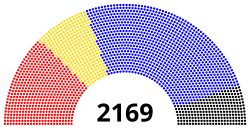Chinese People's Political Consultative Conference 中国人民政治协商会议 | |
|---|---|
| 14th National Committee of the Chinese People's Political Consultative Conference | |
 | |
| Type | |
| Type | |
| History | |
| Founded | 21 September 1949 |
| Preceded by | National Assembly |
| Leadership | |
See list
| |
Main Organ | Plenary Session & Standing Committee of National Committee, CPPCC Plenum of the CPPCC (Historical) |
| Structure | |
| Seats | NC-CPPCC: 2169 NC-CPPCC Standing Committee: 324 |
 | |
NC-CPPCC political groups | CCP, minor parties, and independents (544) People's organizations (313) |
 | |
NC-CPPCC Standing Committee political groups | CCP, minor parties, and independents (193) People's organizations (30) |
Length of term | 5 years |
| Meeting place | |
 | |
| Great Hall of the People, Xicheng District, Beijing City, People's Republic of China | |
| Website | |
| en | |
| Chinese People's Political Consultative Conference | |||||||
|---|---|---|---|---|---|---|---|
| Simplified Chinese | 中国人民政治协商会议 | ||||||
| Traditional Chinese | 中國人民政治協商會議 | ||||||
| |||||||
| Short form | |||||||
| Simplified Chinese | 人民政协 | ||||||
| Traditional Chinese | 人民政協 | ||||||
| Literal meaning | People's Political Consultation | ||||||
| |||||||
| Shortest form | |||||||
| Simplified Chinese | 政协 | ||||||
| Traditional Chinese | 政協 | ||||||
| Literal meaning | Political Consultation | ||||||
| |||||||
| Third alternative Chinese name | |||||||
| Simplified Chinese | 新政协 | ||||||
| Traditional Chinese | 新政協 | ||||||
| Literal meaning | New Political Consultation | ||||||
| |||||||
 |
|---|
|
|
The Chinese People's Political Consultative Conference (CPPCC) is a political advisory body in the People's Republic of China and a central part of the Chinese Communist Party (CCP)'s united front system. Its members advise and put proposals for political and social issues to government bodies.[1] However, the CPPCC is a body without real legislative power.[2] While consultation does take place, it is supervised and directed by the CCP.[2]
The body traditionally consists of delegates from the CCP and its people's organizations, eight legally permitted political parties subservient to the CCP, as well as nominally independent members.[3][4][5] The CPPCC is chaired by a member of the Politburo Standing Committee of the CCP. In keeping with the united front strategy, prominent non-CCP members have been included among the Vice Chairs, examples being Chen Shutong, Li Jishen and Soong Ching-ling.[6]
The organizational hierarchy of the CPPCC consists of a National Committee and regional committees. Regional committees extend to the provincial, prefecture, and county level. According to the charter of the CPPCC, the relationship between the National Committee and the regional committees is one of guidance and not direct leadership. However, an indirect leadership exists via the United Front Work Department at each level.[7][8] The National Committee of the Chinese People's Political Consultative Conference typically holds a yearly meeting at the same time as plenary sessions of the National People's Congress (NPC). The CPPCC National Committee and NPC plenary sessions are collectively called the Quanguo Lianghui ("National Two Sessions").
The CPPCC is intended to be more representative of a broader range of people than is typical of government office in the People's Republic of China, including a broad range of people from both inside and outside the CCP. The composition of the members of the CPPCC changes over time according to national strategic priorities.[9] Previously dominated by senior figures in real-estate, state-owned enterprises, and "princelings", the CPPCC in 2018 was primarily composed of individuals from China's technology sector.[10]
- ^ Tiezzi, Shannon (4 March 2021). "What Is the CPPCC Anyway?". The Diplomat. Archived from the original on 28 March 2024. Retrieved 21 August 2022.
- ^ a b Colin Mackerras; Donald Hugh McMillen; Andrew Watson (2001). Dictionary of the Politics of the People's Republic of China. London: Routledge. p. 70. ISBN 0-203-45072-8. OCLC 57241932.
- ^ Pauw, Alan Donald (1981). "Chinese Democratic Parties as a Mass Organization". Asian Affairs. 8 (6): 372–390. doi:10.1080/00927678.1981.10553834. ISSN 0092-7678. JSTOR 30171852.
- ^ Rees-Bloor, Natasha (15 March 2016). "China's largest political conference – in pictures". The Guardian. ISSN 0261-3077. Retrieved 13 September 2020.
- ^ "The United Front in Communist China" (PDF). Central Intelligence Agency. May 1957. Archived from the original (PDF) on 23 January 2017. Retrieved 10 June 2020.
- ^ Shih, Wen (1 March 1963). "Political Parties in Communist China". Asian Survey. 3 (3): 157–164. doi:10.2307/3023623. ISSN 0004-4687. JSTOR 3023623.
- ^ Bowe, Alexander (24 August 2018). "China's Overseas United Front Work: Background and Implications for the United States" (PDF). United States-China Economic and Security Review Commission. Archived (PDF) from the original on 9 September 2018. Retrieved 12 May 2019.
- ^ Dotson, John (29 May 2020). "Themes from the CPPCC Signal the End of Hong Kong Autonomy—and the Effective End of the "One Country, Two Systems" Framework". Jamestown Foundation. Archived from the original on 7 June 2020. Retrieved 3 June 2020.
- ^ Tatlow, Didi Kirsten (3 March 2016). "Advisory Body's Delegates Offer Glimpse Into China's Worries". The New York Times. ISSN 0362-4331. Archived from the original on 8 November 2020. Retrieved 13 September 2020.
- ^ Yu, Xie; Leng, Sidney (4 March 2018). "Tech entrepreneurs dominate as China's political advisers in IT push". South China Morning Post. Archived from the original on 5 March 2018. Retrieved 6 March 2018.